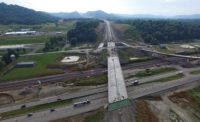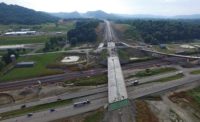The ground in Southern Ohio is a mixture of sandstone and the area is so hilly it required installation of 33 bridges over the 16-mile length of the Southern Ohio Veterans Memorial Highway. The $429-million, four-lane divided road bypasses the city of Portsmouth and creates a connector between Columbus and Cincinnati. The public-private project was the first for the Ohio Dept. of Transportation and was completed on time and within budget in December 2018. To accomplish that feat, The Beaver Excavating Co. had to remove 20 million cu yd of earth composed of 95% rock.
“We set up a team that we think was the best to take on this project. Dragados and then up through ACS [Infrastructure] as the developer brought this P3 experience that needed the local contractors, Beaver and [John R. Jurgenson Co.]. We felt very comfortable that we had a team that could navigate that process,” says Chad Ratkovich, project manager for Beaver Excavating, the contractor responsible for the earthmoving. “Of course, from the earthmoving, we felt that we put a good plan together and we really spent a lot of time constantly updating that plan.”
The P3 team known as the Portsmouth Gateway Group (PGG) included Dragados, Jurgenson, Beaver and ACS. The operate-and-maintain portion of its ODOT contract began in January 2019, and it will extend until 2053. Ratkovich is quick to acknowledge the team aspect of the project and the importance that attitude played in delivering it on time.
“Like any design-build and anything with a significant amount of greenfield, it was how we reacted to change,” he says. “There were some concerning things where we just had to adapt to. … I think that was really the success of this project, the ability to change course quickly and really have all parties, whether that be the department or the design-builder, redirect efforts and institute the change that was necessary to keep things on schedule.”
Bill Maddex, the ACS Infrastructure executive who served as CEO of PGG during construction, echoed those sentiments. “The project itself is testament to the fact that people can assess and assign risks and then responsibly live up to their commitments,” he says. “A lot of projects we see fail because they’ve been poorly put together at the onset. In this case, I think all the right players were on the team, and Chad’s ability to communicate up and down the chain of command was very beneficial.”







Post a comment to this article
Report Abusive Comment